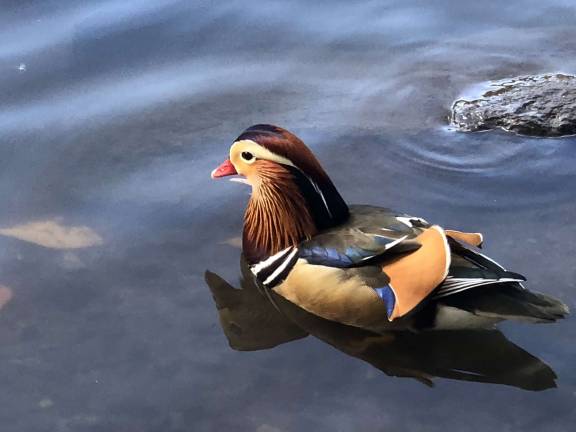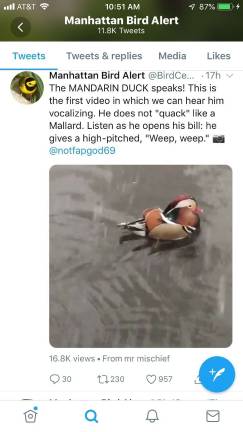tracking the city’s bird news




Nearly a decade ago, Upper East Side resident David Barrett discovered his passion for birding. An avid middle-distance runner, Barrett often jogged or walked through Central Park. To make his walks more enjoyable, he began birding and researching the various birds that he observed.
“I wanted to make those walks as interesting as possible and that’s how it all started,” Barrett explained. “I got interested in birding as a thing to do. It’s a fascinating subject.”
Today, he has racked up a lifetime total of 267 American Bird Association-countable bird species in Manhattan, placing him second on the all-time list for eBird, an online citizen science database, as of November.
In 2013, Barrett launched Manhattan Bird Alert (@BirdCentralPark) and today, the Twitter feed has been front and center as it has helped birders see the Mandarin Duck that has created a sensation in Central Park.
“Manhattan Bird Alert, I think it’s a great thing for all New Yorkers,” Barrett said. “It’s been very popular because of the Mandarin Duck. The purpose of it is to give the public a way to get birding news delivered to them quickly.”
Birders identified the male duck as native to East Asia, and no one was sure how he had made his way to Manhattan.
Manhattan Bird Alert (@BirdCentralPark) has provided regular updates on the duck since his first arrival in October. After a four-day absence earlier this month, the duck returned to the Central Park Pond on Nov. 14. On Thursday, during the first snowfall of the season, the duck enjoyed the snowflakes.
One post via @LRo70 read, “A little snow does not bother the MANDARIN DUCK, still at the Central Park Pond (60th and Fifth).”
Barrett, 54, grew up in Massachusetts and earned his undergraduate degree in mathematics from Harvard. After a long career as a hedge fund manager, he is now an investor and computer scientist.
Since he began birding, he has learned that birds not only can be identified by sight, but by sound as well. Additionally, weather plays a huge role in migration and is a factor in why certain birds may appear in Manhattan for just week or a couple days.
“I think the surprising thing is how we get migrant birds that come from far away,” Barrett said.
After gaining all of this knowledge, he realized that New Yorkers should have an easier way to find birds. So he launched the Bird Alert in Manhattan, Bronx, Brooklyn and Queens.
“We needed a better system that’s fast and can handle a lot of alerts,” he said.
Today, there are 100 approved users that can post alerts on the account.
The alert system provided the first public news of the Harris’s Sparrow on Nov. 4, the Kirtland’s Warbler on May 11, the Hammond’s Flycatcher on Nov. 26, 2017 and the Swainson’s Warbler appearance in Central Park on April 28, 2016. It has been featured in the New York Times, the BBC and the New York Post.
“The alerts quickly became very popular with other birders,” Barrett said. “They could see that it became a great solution to a problem that they had.”